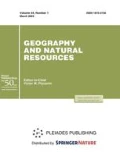Abstract
We examine the impact of roads on geosystems in territories of new development, where the extraction of hydrocarbons motivates especially intensive improvement of the infrastructure. In this study, we consider motor roads beyond the official network, which have been informally constructed, maintained, or used by various organizations or individuals. We represent types of roads with different forms and regimes of management schematically. As the model area for studying the impact of roads on taiga geosystems, we selected a territory in the north of Irkutsk oblast, in the interfluve of the Kirenga and Khanda rivers; field investigations of the transformation of geosystems were carried out along the informal road from the Vershina Khandy village to the Magistral’nyi settlement. Particular attention was paid to the possible intensification of geomorphological processes as one of the crucial factors for changes in geosystems. A comprehensive analysis of geological, geomorphological, and landscape factors using remote sensing data and field studies made it possible to compile a geomorphological map with identification of dangerous exogenous processes along these roads. Major causes for landscape disturbances were identified, namely degradation and transformation of vegetation cover and changes in the temperature regime of permafrost, which lead to waterlogging and subsidence of soils and, consequently, to the formation of multiple tracks along the roadside and intensified linear erosion.





Similar content being viewed by others
REFERENCES
Mil'kov, F.N., Anthropogenic landscape science, the subject of study, and the current state, Vopr. Geogr., 1977, no. 106, pp. 11–27.
Smirnykh, A.G., Change of landscapes during the construction and operation of highways in the steppe and dry-steppe zones of the Urals, Geogr. Prir. Resur., 1986, no. 2, pp. 95–101.
Schweitzer, P., Povoroznyuk, O., and Schiesser, S., Beyond wilderness: Towards an anthropology of infrastructure and the built environment in the Russian north, Polar J., 2017, vol. 7, pp. 58–85.
Ibisch, P.L., Hoffmann, M.T., Kreft, S., Pe’er, G., Kati, V., and Biber-Freudenberger, L., DellaSala, D.A., Vale, M.M., Hobson, P.R., and Selva, N., A global map of roadless areas and their conservation status, Science, 2016, vol. 354, pp. 1423–1427.
Auerbach, N.A., Walker, M.D., and Walker, D.A., Effects of roadside disturbance on substrate and vegetation properties in Arctic tundra, Ecol. Appl., 1997, vol. 7, pp. 218–235.
Rapid Arctic Transitions due to Infrastructure and Climate (RATIC). A Contribution to ICARP III. Alaska Geobotany Center Publication AGC 15-02, Walker, D. and Peirce, J., Eds., Fairbanks: Univ. of Alaska Fairbanks, 2015.
Khitun, O.V., Self-recovery after technogenic and natural disturbances in the central part of the Yamal Peninsula (Western Siberian Arctic), in Disturbance and Recovery in Arctic Lands: An Ecological Perspective, Dordrecht: Kluwer Acad. Publ., 1997, pp. 531–562.
Kumpula, T., Pajunen, A., Rvi, E., Forbes, B., and Stammler, F., Land use and land cover change in Arctic Russia: Ecological and social implications of industrial development, Global Environ. Change, 2011, no. 21, pp. 550–562.
Myachina, K.V., Investigation of the dynamics of the landscape structure of oil-producing territories of the steppe zone of the Cis-Urals using GIS technologies based on satellite data, Geoinformatika, 2016, no. 2, pp. 2–13.
Arima, E., Walker, R., Perz, S., and Souza, C., Explaining the fragmentation in the Brazilian Amazonian forest, J. Land Use Sci., 2015, vol. 11, no. 3, pp. 257–277.
Brandão, A.O. and Souza, C.M., Mapping unofficial roads with Landsat images: A new tool to improve the monitoring of the Brazilian amazon rainforest, Int. J. Remote Sensing, 2006, vol. 27, pp. 177–189.
Hughes, A.C., Global roadless areas: Hidden roads, Science, 2017, vol. 355, p. 1381.
Molyarenko, O.A., Unowned motor roads in Russia, EKO, 2017, no. 4, pp. 88–109.
Vasil'eva, V.V., Infrastructure outside the state: “Wild” winter trails and the export of commercial products in Taimyr, Etnogr. Obozr., 2019, no. 4, pp. 61–75. http:// ras.jes.su/ethnorev/s086954150006192-1-1. Accessed November 23, 2019.
Trombold, Ch., Ancient Road Networks and Settlement Hierarchies in the New World, Cambridge: Cambridge Univ. Press, 1991, pp. 124–125.
Kuklina, V., Petrov, A., Krasnoshtanova, N., and Bogdanov, V., Mobilizing benefit sharing through transportation infrastructure: Informal roads, extractive industries and benefit sharing in the Irkutsk oil and gas region, Russia, Resources, 2020, vol. 9, no. 3. Accessed November 23, 2019.https://doi.org/10.3390/resources9030021
Ishmuratov, B.M., Geographic foundations of managing the development of new areas, Geogr. Prir. Resur., 1988, no. 4, pp. 5–17.
Ragulina, M.V., Vershino-Khandinskaya Evenk community, in Otsenka sovremennogo sostoyaniya okruzhayushchei prirodnoi sredy territorii Kovyktinskogo gazokondensatnogo mestorozhdeniya (Assessment of the Current State of the Environment in the Territory of the Kovykta Gas Condensate Field), Irkutsk: Inst. Geogr. Sib. Otd. Ross. Akad. Nauk, 2004, pp. 47–57.
Khandinskaya Neighbor-Territorial Evenk Community. https://kultura.irk.muzkult.ru/Handa. Accessed November 23, 2019.
Mikheev, V.S. and Ryashin, V.A., Landshafty yuga Vostochnoi Sibiri: Karta. M-b 1:1 500 000 (Landscapes of the South of Eastern Siberia: Map. Scale 1:1 500 000), Moscow: GUGK, 1977.
Ekologicheskoe orientirovannoe planirovanie zemlepol’zovaniya v Baikal’skom regione. Kovyktinskoe gazokondensatnoe mestorozhdenie (Environmental Oriented Land Use Planning in the Baikal Region. Kovykta Gas Condensate Field), Suvorov, E.G. and Makarov, S.A., Eds., Irkutsk: Inst. Geogr. Sib. Otd. Ross. Akad. Nauk, 2004.
Chesnokova, I.V. and Lokshin, G.P., Tekhnogennye fizicheskie polya - svoistva antropogenno-geomorfologicheskikh sistem (Man-Made Physical Fields: Properties of Anthropogenic-Geomorphological Systems), Moscow: Media-Press, 2016.
Kuz'min, S.B. and Lopatkin, D.A., Principles of regionalization of the Baikal region by hazardous geomorphological processes for the purpose of their mapping, Geod. Kartogr., 2018, vol. 79, no. 2, pp. 22–35.
Funding
This work was financially supported by the National Science Foundation (United States) within the framework of the Informal Roads: The Impact of Unofficial Transport Routes on Remote Arctic Communities project (174809).
Author information
Authors and Affiliations
Corresponding authors
Additional information
Translated by K. Lazarev
Rights and permissions
About this article
Cite this article
Bilichenko, I.N., Kobylkin, D.V., Kuklina, V.V. et al. Development of the Informal Road Network and Its Impact on the Transformation of Taiga Geosystems in the North of Irkutsk Oblast. Geogr. Nat. Resour. 42, 148–155 (2021). https://doi.org/10.1134/S1875372821020037
Received:
Revised:
Accepted:
Published:
Issue Date:
DOI: https://doi.org/10.1134/S1875372821020037




